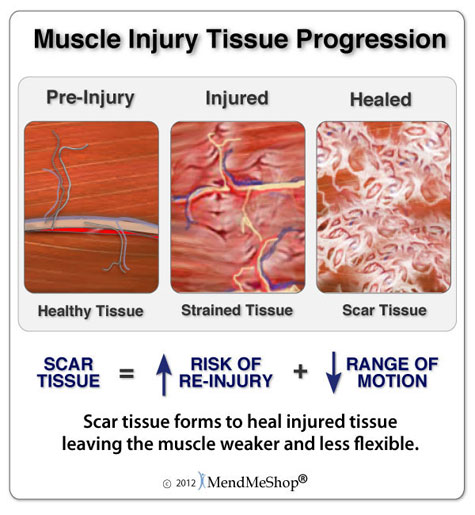Understanding Dwyane Wade and Derrick Rose’s Hamstring Problem
- Post By: Jeff Stotts
- Date:
- Category: NBA, Understanding...
It should come as now surprise that one of the major issues affecting NBA players this season is lower extremity problems. Ankle and foot injuries, including fractures and sprains, make up 35 percent of the missed games this season. Meanwhile injuries to the musculature of the lower extremities are also making an impact, as strains to the calf, groin, and hamstring account for 19 percent of all games missed.
Recently two All-Stars, Miami’s Dwyane Wade and Chicago’s Derrick Rose, joined the list with both players missing time due to hamstring strains. Both players, who have displayed a tendency to be injured, are optimistic for a quick return. However there are multiple reasons as to why they should not rush recovery and continue with their current conservative approach.
To begin, the healing process for muscle tissue is extremely complex and intricate and does not guarantee that the injured muscle tissue will return to its original integrity. As its name suggests, the healing process occurs in multiple stage that is initiated with the inflammatory phase. This stage is marked by the initial swelling and clotting reactions at the site of injury. The next stage, the proliferative phase, overlaps with the inflammatory phase but marks the beginning of the body’s actually repair work on the damaged tissue. As the proliferative phase progresses, scar tissue begins to form as specialized cells begin filling in the injury site with protein fibers, including collagen and elastin.

The proliferative phase generally takes multiple weeks to complete. Once finished, the final phase, known as the remodeling phase, begins. The remodeling phase varies in length and is dependent on the amount of associated damage. It has been reported that Wade and Rose both have Grade I strains, the least severe of all the strains. However despite the low grade, the remodeling phase remains vital to a complete recovery. During this final phase, collagen fibers within the scar tissue are repeatedly broken down and remade to increase strength by properly aligning the injured muscle fibers to resemble healthy tissue. This is where a good medical team comes into play.
During rehab, an athletic trainer or physical therapist can help the injured individual load the effected muscle in a specific way. This approach will combat the body’s predisposed and haphazard way of healing and help the new muscle tissue develop in a stronger, more accurate pattern.
Unfortunately the new tissue is still vulnerable to injury even when properly managed. If the scar tissue is not 100 percent and is disrupted, the injured player must hit the reset button on the entire process and begin the tedious process of tissue regeneration all over again. This is precisely why hamstring and other muscle strains of the leg require long periods of rest and why teams often adopt a disciplined approach to care. It also helps explain why hamstring strains are easily re-injured. (ie. Golden State’s David Lee or Los Angeles Lakers forward Ryan Kelly) In short, a functional muscle doesn’t necessarily mean a healthy muscle.
For Rose and Wade, their lengthy injury histories must also be considered. Both players have suffered hamstring strains before. Wade missed nine games last season with a left hamstring strain, the same leg currently affected. Rose’s previous strain occurred to his opposite leg and cost him just one game.
However the potential side effects of the hamstring injury on each player’s troublesome knees is the real concern. The entire lower extremity should be viewed as a chain, with each link representing one of the areas of the leg. If one link, like the muscles of the leg, is weakened or not functioning correctly, the strength and ability of the entire chain is compromised. The other links (the knee, ankle, hip, and foot) must undergo a compensational shift to make up for the weakened musculature, resulting in an unnecessary stress placed on and through the other areas of the affected limb. As a result, the player’s inherent injury risk increases, leaving the ligaments and other tissues susceptible to a more significant injury. Remember Rose tore the meniscus in his right knee just seven days after missing time with a right hamstring strain. There’s no guarantee it was the root of Rose’s injury but it cannot be ruled out as a contributing factor.
The last thing Miami or Chicago needs is another serious injury to their respective guard. Both players will be managed carefully moving forward and rightfully so. While the former All-Stars, particularly Rose, have undergone scrutiny for their cautious approach to seemingly minor injuries, a conservative treatment plan remains the best course of action for all involved parties.
[…] lost to hamstring-related problems, the most for any muscle-related injury. InStreetClothes.com previously detailed why these types of injuries are so problematic in the NBA, but let’s once again […]